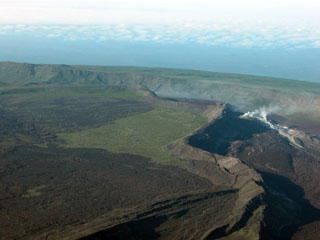Report on Sierra Negra (Ecuador) — 4 July-10 July 2018
Smithsonian Institution / US Geological Survey
Weekly Volcanic Activity Report, 4 July-10 July 2018
Managing Editor: Sally Sennert.
Please cite this report as:
Global Volcanism Program, 2018. Report on Sierra Negra (Ecuador) (Sennert, S, ed.). Weekly Volcanic Activity Report, 4 July-10 July 2018. Smithsonian Institution and US Geological Survey.
Sierra Negra
Ecuador
0.83°S, 91.17°W; summit elev. 1124 m
All times are local (unless otherwise noted)
IG reported that a new magmatic intrusion at Sierra Negra was heralded by a M 5.2 earthquake recorded at 1830 on 4 July, and followed by 68 events between M 1.1 and 3.9. Seismic tremor began to be recorded at 1700 on 7 July by a station on the NE edge of the caldera. At the same time satellite data showed an increase in the intensity of the thermal anomaly on NW flank (it had decreased the previous day). Parque Nacional Galápagos staff confirmed strong incandescence in an area near the beach. A weak plume of water vapor and ash rose as high as 3.3 km (10,800 ft) a.s.l. and drifted SW and W. Tremor continued to be registered on 8 July, though the amplitude gradually decreased. Vapor-and-ash plumes reported by the Washington VAAC rose about 2 km (6,600 ft) a.s.l. and drifted SW, and the thermal anomaly remained intense. Gas clouds drifted 115 km W.
The current eruption at Sierra Negra began on 26 June and, according to news articles, prompted tourist restrictions and the evacuation of 50 residents.
Geological Summary. The broad shield volcano of Sierra Negra at the southern end of Isabela Island contains a shallow 7 x 10.5 km caldera that is the largest in the Galápagos Islands. Flank vents abound, including cinder cones and spatter cones concentrated along an ENE-trending rift system and tuff cones along the coast and forming offshore islands. Although it is the largest of the five major Isabela volcanoes, it has the flattest slopes, averaging less than 5° and diminishing to 2° near the coast. A sinuous 14-km-long, N-S-trending ridge occupies the west part of the caldera floor, which lies only about 100 m below its rim. The Volcán de Azufre fumarolic area lies within a graben between this ridge and the west caldera wall. Lava flows from a major eruption in 1979 extend all the way to the north coast from circumferential fissure vents on the upper northern flank.
Sources: Instituto Geofísico-Escuela Politécnica Nacional (IG-EPN), BBC News

